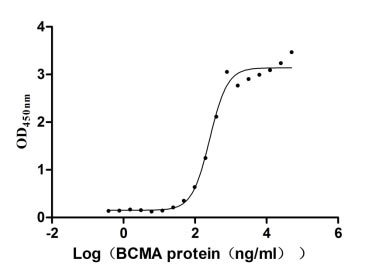Recombinant Human Ras-related GTP-binding protein C (RRAGC)
-
中文名称:人RRAGC重组蛋白
-
货号:CSB-YP867190HU
-
规格:
-
来源:Yeast
-
其他:
-
中文名称:人RRAGC重组蛋白
-
货号:CSB-EP867190HU
-
规格:
-
来源:E.coli
-
其他:
-
中文名称:人RRAGC重组蛋白
-
货号:CSB-EP867190HU-B
-
规格:
-
来源:E.coli
-
共轭:Avi-tag Biotinylated
E. coli biotin ligase (BirA) is highly specific in covalently attaching biotin to the 15 amino acid AviTag peptide. This recombinant protein was biotinylated in vivo by AviTag-BirA technology, which method is BriA catalyzes amide linkage between the biotin and the specific lysine of the AviTag.
-
其他:
-
中文名称:人RRAGC重组蛋白
-
货号:CSB-BP867190HU
-
规格:
-
来源:Baculovirus
-
其他:
-
中文名称:人RRAGC重组蛋白
-
货号:CSB-MP867190HU
-
规格:
-
来源:Mammalian cell
-
其他:
产品详情
-
纯度:>85% (SDS-PAGE)
-
基因名:
-
Uniprot No.:
-
别名:AU041672; FLJ13311; GTPase interacting protein 2; GTPase-interacting protein 2; GTR2; MGC47404; OTTHUMP00000000548; Rag C; Rag C protein; RAGC; Ras related GTP binding C; Ras-related GTP-binding protein C; RP23 29H22.4; RRAGC; RRAGC_HUMAN; TIB929; YGR163W
-
种属:Homo sapiens (Human)
-
蛋白长度:Full Length of Mature Protein
-
表达区域:2-399
-
氨基酸序列SLQYGAEET PLAGSYGAAD SFPKDFGYGV EEEEEEAAAA GGGVGAGAGG GCGPGGADSS KPRILLMGLR RSGKSSIQKV VFHKMSPNET LFLESTNKIY KDDISNSSFV NFQIWDFPGQ MDFFDPTFDY EMIFRGTGAL IYVIDAQDDY MEALTRLHIT VSKAYKVNPD MNFEVFIHKV DGLSDDHKIE TQRDIHQRAN DDLADAGLEK LHLSFYLTSI YDHSIFEAFS KVVQKLIPQL PTLENLLNIF ISNSGIEKAF LFDVVSKIYI ATDSSPVDMQ SYELCCDMID VVIDVSCIYG LKEDGSGSAY DKESMAIIKL NNTTVLYLKE VTKFLALVCI LREESFERKG LIDYNFHCFR KAIHEVFEVG VTSHRSCGHQ TSASSLKALT HNGTPRNAI
-
蛋白标签:Tag type will be determined during the manufacturing process.
The tag type will be determined during production process. If you have specified tag type, please tell us and we will develop the specified tag preferentially. -
产品提供形式:Lyophilized powder
Note: We will preferentially ship the format that we have in stock, however, if you have any special requirement for the format, please remark your requirement when placing the order, we will prepare according to your demand. -
复溶:We recommend that this vial be briefly centrifuged prior to opening to bring the contents to the bottom. Please reconstitute protein in deionized sterile water to a concentration of 0.1-1.0 mg/mL.We recommend to add 5-50% of glycerol (final concentration) and aliquot for long-term storage at -20℃/-80℃. Our default final concentration of glycerol is 50%. Customers could use it as reference.
-
储存条件:Store at -20°C/-80°C upon receipt, aliquoting is necessary for mutiple use. Avoid repeated freeze-thaw cycles.
-
保质期:The shelf life is related to many factors, storage state, buffer ingredients, storage temperature and the stability of the protein itself.
Generally, the shelf life of liquid form is 6 months at -20°C/-80°C. The shelf life of lyophilized form is 12 months at -20°C/-80°C. -
货期:Delivery time may differ from different purchasing way or location, please kindly consult your local distributors for specific delivery time.Note: All of our proteins are default shipped with normal blue ice packs, if you request to ship with dry ice, please communicate with us in advance and extra fees will be charged.
-
注意事项:Repeated freezing and thawing is not recommended. Store working aliquots at 4°C for up to one week.
-
Datasheet :Please contact us to get it.
相关产品
靶点详情
-
功能:Guanine nucleotide-binding protein that plays a crucial role in the cellular response to amino acid availability through regulation of the mTORC1 signaling cascade. Forms heterodimeric Rag complexes with RRAGA or RRAGB and cycles between an inactive GTP-bound and an active GDP-bound form. In its active form participates in the relocalization of mTORC1 to the lysosomes and its subsequent activation by the GTPase RHEB. This is a crucial step in the activation of the TOR signaling cascade by amino acids. ...显示更多
-
基因功能参考文献:
- Multiple RRAGC mutations demonstrated elevated MTOR activation. PMID: 27267853
- Full-length RagA(GTP):RagC(GDP) dimer binds to regulator to activate mTORC1. PMID: 29107538
- The dynamic response of mTORC1 requires intersubunit communication by the Rag GTPases, providing a rationale for why they exist as a dimer and revealing a distinct mode of control for a GTP-binding protein. PMID: 29056322
- These findings implicate mTORC1 dysregulation through a gain-of-function mutation in RagC as a novel molecular basis for syndromic forms of pediatric heart failure, and expand genotype-phenotype correlation in RASopathy-related syndromes PMID: 27234373
- activating nature of the RRAGC mutations, their existence in the dominant clone and their stability during disease progression support their potential as an excellent candidate for therapeutic targeting PMID: 26691987
收起更多
-
相关疾病:RRAGC mutations have been found in a patient with idiopathic dilated cardiomyopathy with ventricular dilation and systolic dysfunction, bilateral cataracts, and mild facial dysmorphisms.
-
亚细胞定位:Cytoplasm. Nucleus. Lysosome.
-
蛋白家族:GTR/RAG GTP-binding protein family
-
数据库链接:
HGNC: 19902
OMIM: 608267
KEGG: hsa:64121
STRING: 9606.ENSP00000362092
UniGene: Hs.532461



-AC1.jpg)
f4-AC1.jpg)















